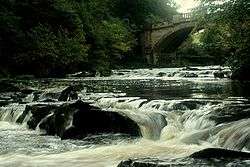River Almond, Lothian

- Not to be confused with the River Almond, Perth and Kinross
The River Almond (Scottish Gaelic: Abhainn Amain) is a river in Lothian, Scotland. It is 28 miles (45 km) long, rising at Hirst Hill in Lanarkshire near Shotts and running through West Lothian, draining into the Firth of Forth at Cramond, Edinburgh. The name Almond/Amon is simply old Celtic for "river".[1] The river has a good example of an ox-bow lake near Almondvale West at Livingston.
Running through what were, for much of the 20th century, areas dominated by heavy industry and shale and coal mining, the River Almond has been notorious for its high levels of pollution. With the demise of mining and heavy industry in Central Scotland the river is now relatively clean and is being actively repopulated by wildlife, including a healthy population of brown trout and improving runs of both Atlantic salmon (Salmo salar) and sea trout (Salmo trutta). There is a good array of birds to be seen around the river banks, including dippers, kingfishers and grey herons, with increasing numbers of otters being reported. The river is still the primary means of transporting southern West Lothian's waste water to the sea. While the introduction of a number of water treatment plants have helped to mitigate the effects of pollution, the river still suffers from high levels of detergent pollution along with run-off from agricultural land. This has led to the river often having a distinct "chemical odour". This is most noticeable within Almondell and Calderwood Country Park, where there is a major outfall from the nearby East Calder treatment plant.
The river runs through the centre of Livingston before travelling through Almondell and Calderwood Country Park where it picks up the Calder and Murieston Waters. It then passes over a weir which supplies a feeder culvert which carries water into the Union Canal. Due to the height difference where the river passes under the canal, this feeder must run for many miles eastwards before reaching the canal. By following paths through the country park and along private land to the east it is possible to follow the river and feeder all the way to the Union Canal. The river then flows east under the Union Canal before turning northwards towards the Firth of Forth. Fishing on the lower Almond is leased from the Crown Estate by Cramond Angling Club, with both Day and Season Tickets available. The mouth of the Almond at Cramond formerly had a small passenger ferry. In 1997 the ferryman discovered the Cramond Lioness, a Roman-era sculpture, in the mud of the river bed. The sculpture is now in the Museum of Scotland in Edinburgh.
The industrial heritage of central Scotland can be observed along the length of the river with numerous weirs, remains of mills and other riverside industries of the past.
References
- ↑ History of Livingstone, William F Hendrie
External links
- "Overview of Almond, River", Gazetteer of Scotland, accessed November 20, 2009.
- "Cramond Angling Club"
- "Forth District Salmon Fishery Board"
- "River Forth Fisheries Trust"
Coordinates: 55°58′44″N 3°18′07″W / 55.97889°N 3.30194°W